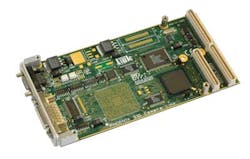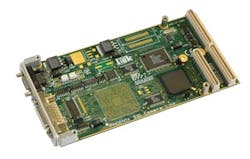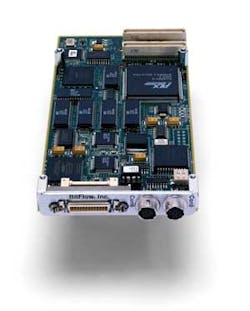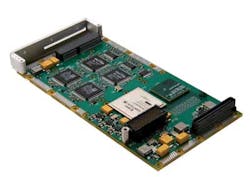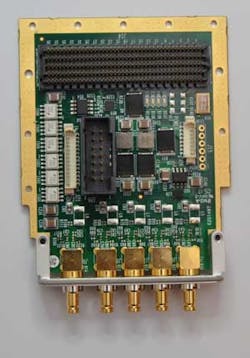Andrew Wilson, Editor
Both the VME and CompactPCI computer architectures allow different types of computer and peripheral I/O boards to be configured as industrial embedded systems. As well as configuring such systems using separate VME and CompactPCI cards to perform I/O tasks such as image acquisition, developers can also choose from a number of different PMC, XMC and FMC mezzanine cards with which to populate 3U and 6U carrier cards.
These include the PCI Mezzanine Card (PMC) that incorporates the PCI bus in a Common Mezzanine Card (CMC format), the Switched Mezzanine Card (XMC), a PMC format card that supports the PCI Express standard and the FPGA Mezzanine Card (FMC) that provides a standard mezzanine card form factor, connectors, and modular interface to an FPGA located on a carrier board.
Add-in cards
Based on the PCI standard interface, PMC cards feature a module size of 149 mm x 74 mm allowing, a 6U VME or Compact PCI carrier board to hold two such mezzanine boards. While two connectors (P11 and P12) are used to implement a 32-bit PCI bus, the addition of the P13 connector allows a 64-bit bus to be achieved. Running at 33 or 66MHz clock speeds, peak data transfer rates of 132 or 264 MBytes/s allow such cards to handle the bandwidth required by many analog and digital image data formats. An optional P14 connector found on some PMC cards is used for 64 bits of user-defined I/O.
For designers of embedded imaging systems, a host of PMC mezzanine cards are available that allow both analog and digital image data to be captured. For analog image capture from color, video, blanking, and sync (CVBS) standard formats such as PAL/NTSC, a number of frame grabbers are available that can be used to DMA image data to the host carrier card reducing CPU overhead. Examples of such analog frame grabbers include the p3i_ASYNC/PM from Eltec (Mainz, Germany; www.eltec.de) that allows images from up to four non-synchronized cameras to be digitized.
Numerous PMC offerings are also available for the well-established Camera Link interface standard. To interface directly to Base Camera Link cameras, both Active Silicon (Iver, England; www.activesilicon.com) and BitFlow (Woburn, MA, USA; www.bitflow.com) offer 32-bit/33MHz PMC cards (Figure 1). For developers wishing to extend the 10m (maximum) camera to computer limitation of Camera Link, EDT (Beaverton, OR, USA) has developed a PMC-based fiber optic interface that can be used to interface one Medium or up to two Base-mode cameras up to 100 km from the host computer by pairing the board with one or two RCX C-Link fiber-optic converters.
Greater bandwidth
In PMC cards, four, 64-pin 10mm high connectors can be used to implement a 64-bit bus and user defined I/O. Since bandwidth is limited by the parallel bus backplane, the next generation of mezzanine cards known as switched fabric (XMC) boards adds two additional 114 pin connectors (P15 and P16) connectors for serial high-speed interfaces such as PCI Express and Serial Rapid IO. Based on the PMC mechanical definition, the boards also feature a module size of 149 mm x 74 mm. While the P15 primary connector features 20 differential I/O pairs, and pins for voltage, ground, and reset among others, the P16 connector incorporates 20 differential I/O pairs and an additional 38 user I/O pins.
Although both the P11-P14 and the P15-P15 connectors can be present in XMC mezzanine cards, some XMC implementations use the P14 connector and use the P15 connector in place of the P11-P13 connectors. Incorporating the P11-P14 and the P15-P15 connectors, the XMC's 149 mm x 74 mm form factor can however, be reduced to 139mm in length if the P11-P14 connectors are not used. Incorporating switched fabric busses such as PCI Express on XMC cards results in faster data rates since the bus arbitration of the PCI bus is eliminated. Using both the P15 and P16 connector to support PCI Express, for example could maximum data rates as fast as 4Gbits/s (for PCI Express 2.0).
Here again, a number of different mezzanine cards are available that support both analog and digital cameras. The XMC-270 frame grabber, Curtiss-Wright Defense Solutions (Ashburn, VA, USA; www.cwcdefense.com), for example, is an XMC card that can be configured to accept six CVBS/S-Video NTSC, PAL or RS-170 inputs, dual DVI and dual progressive scan RGB inputs (Figure 2). For high-speed digital cameras needing to transfer image data over dual 10Gigabit Ethernet networks, Kontron (Eching, Germany; www.kontron.com) has developed the XMC402, an XMC card that allows two independent 10G Ethernet copper interfaces to be connected using RJ45 connectors.
No FPGA required
Because the PMC and XMC standards are based around traditional parallel bus and newer switched fabric architectures, respectively, it has been relatively easy for PC add-in frame grabber vendors to re-spin their products to meet both PMC and XMC standards. In many such cases, these frame grabbers incorporate FPGAs for image data pre-processing and image formatting to offload the host PC from performing such tasks.
With the introduction of the FPGA Mezzanine Card (FMC) standard in 2008, however, it is now possible to develop frame grabbers that offload the task of such processing to the FPGA located on the carrier board thus simplifying the design of such products.
Unlike PMCs and XMCs, the FMC standard interface is not based on specific bus architecture but rather a set of control lines and data paths that allow I/O circuitry to be directly interfaced to the FPGA on the carrier card. This interface is provided by a single low pin count (LPC) connector with 68 user-defined single ended signals or 34 user-defined differential pairs, a single serial transceiver pair as well as additional clocking and interface signals. Alternatively, a high pin count connector (HPC) that provides 160 user-defined single ended signals or 80 user-defined differential pairs and 10 serial transceiver pairs as well as additional clocking and interface signals can be used.
Several companies have already taken advantage of this concept by introducing FMC cards that can be used to capture both Camera Link and CoaXPress (CXP) data from high-speed cameras. The FMC-CAMERALINK board from Alpha Data Parallel Systems (Edinburgh, Scotland; www.alpha-data.com), for example, supports two Base Camera Link cameras, or one Medium or Full Camera Link camera with or without Power over Camera Link (PoCL) while the FMC-200 programmable FMC card from Integre Technologies (Pittsford, NY, USA; www.integretek) is capable of capturing video from Base, Medium, Full and Extended mode cameras.
For those developers wishing to support higher speed interfaces such as CXP, the FMC-CXP from KAYA Instruments (Nesher, Israel; www.kayainstruments.com) is capable of capturing video from up to five CXP cameras using front panel DIN 1.0/2.3 connectors (Figure 3). Each host link is capable of providing 13W of power to compatible devices via Power over CoaXPress (PoCXP).
Benefits of implementing image capture devices using the FMC standard allows simpler and lower-cost designs to be engineered while at the same time supporting increased throughput between the mezzanine card and host card and carrier card. However, although FMCs from different vendors will be electrically and mechanically compatible, custom FPGA code must be written either by the supplier of the FMC module, by the carrier card vendor or the systems integrator to support the card.
For further reading
"Designing an FMC video acquisition module with Camera Link interface" (http://bit.ly/1bSAsxR)
"How Does the FMC (FPGA Mezzanine Card) Standard Measure up Against the PMC/XMC Format for Embedded Defense/Aerospace Applications" (http://bit.ly/1hJF3ka)
"Development of a front-end data acquisition system with a Camera Link FMC for X-ray imaging detectors" (http://1.usa.gov/1mNXMhw)
Companies mentioned
Active Silicon
Iver, England
www.activesilicon.com
Alpha Data Parallel Systems
Edinburgh, Scotland
www.alpha-data.com
BitFlow
Woburn, MA, USA
www.bitflow.com
Curtiss-Wright Defense Solutions
Ashburn, VA, USA
www.cwcdefense.com
EDT
Beaverton, OR, USA
www.edt.com
Eltec
Mainz, Germany
www.eltec.de
Integre Technologies
Pittsford, NY, USA
www.integretek
KAYA Instruments
Nesher, Israel
www.kayainstruments.com
Kontron
Eching, Germany
www.kontron.com
Vision Systems Articles Archives
About the Author

Andy Wilson
Founding Editor
Founding editor of Vision Systems Design. Industry authority and author of thousands of technical articles on image processing, machine vision, and computer science.
B.Sc., Warwick University
Tel: 603-891-9115
Fax: 603-891-9297
